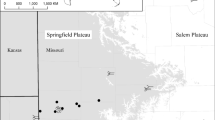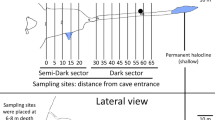Abstract
Submarine caves are considered as a top priority for conservation, but the effects of common pressures are poorly known for these habitats. Here, we examined the effect of recreational human visitation on a selection of submarine caves in a Mediterranean Marine Protected Area (40°35′40″N; 8°11′39″E) where diving activities are regulated. Sampling was conducted in visited and not visited caves to assess whether diving activities have a significant effect on cave habitats, what are the components of biodiversity most affected by this disturbance, and its potential effects on spatial heterogeneity of benthic assemblages. Results clearly showed that human visitation could significantly affect spatial patterns of benthic assemblages. Organisms with erect growth forms were significantly more abundant and homogeneously distributed where diving activities are forbidden. An increase in the small-scale heterogeneity of assemblages and a decrease in their three-dimensional structure could be the ultimate consequences of human visitation. The interaction between specific stressors and the patterns of distribution of species and assemblages can drive their spatial heterogeneity also in unique habitats like marine caves, representing an early warning for the development of appropriate management measures.



Similar content being viewed by others
References
Abdulla A, Gomei M, Maison E, Piante C (2008) Status of marine protected areas in the Mediterranean Sea. IUCN, Malaga and WWF, France
Airoldi L, Cinelli F (1996) Variability of fluxes of particulate material in a submarine cave with chemolithoautotrophic inputs of organic carbon. Mar Ecol-Prog Ser 139:205–217
Anderson MJ (2001) Permutation tests for univariate or multivariate analysis of variance and regression. Can J Fish Aquat Sci 58:626–639
Anderson MJ, Ellingsen KE, McArdle BH (2006) Multivariate dispersion as a measure of beta diversity. Ecol Lett 9:683–693
Anderson MJ, Gorley RN, Clarke KR (2008) PERMANOVA + for PRIMER: guide to software and statistical methods. PRIMER-E, Plymouth
Badalamenti F, Ramos AA, Voultsiadou E, Lizaso LJS et al (2000) Cultural and socio-economic impacts of Mediterranean marine protected areas. Environ Conserv 27:110–125
Ballesteros E (2006) Mediterranean coralligenous assemblages: a synthesis of present knowledge. Oceanogr Mar Biol 44:123–195
Barker NHL, Roberts CM (2004) Scuba diver behaviour and the management of diving impacts on coral reefs. Biol Conserv 120:481–489
Benedetti-Cecchi L, Airoldi L, Abbiati M, Cinelli F (1997) Exploring the causes of spatial variation in an assemblage of benthic invertebrates from a submarine cave with sulphur springs. J Exp Mar Biol Ecol 208:153–168
Bussotti S, Terlizzi A, Fraschetti S, Belmonte G, Boero F (2006) Spatial and temporal variability of sessile benthos in shallow Mediterranean marine caves. Mar Ecol-Prog Ser 325:109–119
Castilla JC (1999) Coastal marine communities: trends and perspectives from human-exclusion experiments. Trends Ecol Evol 14:280–283
Castilla JC (2000) Roles of experimental marine ecology in coastal management and conservation. J Exp Mar Biol Ecol 250:3–21
Chevaldonné P, Lejeusne C (2003) Regional warming-induced species shift in North-West Mediterranean marine caves. Ecol Lett 6:371–379
Clarke KR (1993) Nonparametric multivariate analyses of changes in community structure. Aust J Ecol 18:117–143
Davis D, Tisdell C (1995) Recreational scuba-diving and carrying capacity in marine protected areas. Ocean Coast Manage 26:19–40
Davis D, Tisdell C (1996) Economic management of recreational scuba diving and the environment. J Environ Manage 48:229–248
Denitto F, Terlizzi A, Belmonte G (2007) Settlement and primary succession in a shallow submarine cave: spatial and temporal benthic assemblage distinctness. Mar Ecol-Evol Persp 28:35–46
Dethier MN, Graham ES, Cohen S, Tear LM (1993) Visual versus random-point percent cover estimations—objective is not always better. Mar Ecol-Prog Ser 96:93–100
Di Franco A, Milazzo M, Baiata P, Tomasello A, Chemello R (2009) Scuba diver behaviour and its effects on the biota of a Mediterranean marine protected area. Environ Conserv 36:32–40
Di Franco A, Ferruzza G, Baiata P, Chemello R, Milazzo M (2010) Can recreational scuba divers alter natural gross sedimentation rate? A case study from a Mediterranean deep cave. ICES J Mar Sci 67:871–874
Ford DC, Williams PW (2007) Karst hydrology and geomorphology, 2nd edn. Wiley, London
Fraschetti S, Bianchi CN, Terlizzi A, Fanelli G, Morri C, Boero F (2001) Spatial variability and human disturbance in shallow subtidal hard substrate assemblages: a regional approach. Mar Ecol-Prog Ser 212:1–12
Garrabou J, Sala E, Arcas A, Zabala M (1998) The impact of diving on rocky sublittoral communities: a case study of a bryozoan population. Conserv Biol 12:302–312
Glasby TM (1997) Analysing data from post-impact studies using asymmetrical analyses of variance: a case study of epibiota on marinas. Aust J Ecol 22:448–459
Halpern BS, Selkoe KA, Micheli F, Kappel CV (2007) Evaluating and ranking the vulnerability of global marine ecosystems to anthropogenic threats. Conserv Biol 21:1301–1315
Harmelin JG (1997) Diversity of bryozoans in a Mediterranean sublittoral cave with bathyal like conditions: role of dispersal processes and local factors. Mar Ecol-Prog Ser 153:139–152
Harriott V, Davis D, Banks SA (1997) Recreational diving and its impact in marine protected areas in Eastern Australia. Ambio 26:173–179
Hawkins JP, Roberts CM, Kooistra D, Buchan K, White S (2005) Sustainability of scuba diving tourism on coral reefs of Saba. Coast Manage 33:373–387
Hewitt JE, Thrush SF (2009) Do species’ abundances become more spatially variable with stress? Open Ecol J 2:37–46
Hewitt J, Thrush S, Lohrer A, Townsend M (2010) A latent threat to biodiversity: consequences of small-scale heterogeneity loss. Biodivers Conserv 19:1315–1323
Lambshead PJD, Platt HM, Shaw KM (1983) The detection of differences among assemblages of marine benthic species based on an assessment of dominance and diversity. J Nat Hist 17:859–874
Lester SE, Halpern BS (2008) Biological responses in marine no-take reserves versus partially protected areas. Mar Ecol-Prog Ser 367:49–56
Lloret J, Marin A, Marin-Guirao L, Carreno MF (2006) An alternative approach for managing scuba diving in small marine protected areas. Aquat Conserv-Mar Freshw Ecosyst 16:579–591
Lloret J, Zaragoza N, Caballero D, Riera V (2008) Impacts of recreational boating on the marine environment of Cap de Creus (Mediterranean Sea). Ocean Coast Manage 51:749–754
Lotze HK, Coll M, Magera AM, Ward-Paige C, Airoldi L (2011) Recovery of marine animal populations and ecosystems. Trends Ecol Evol 26:595–605
Luna B, Perez CV, Sanchez-Lizaso JL (2009) Benthic impacts of recreational divers in a Mediterranean marine protected area. ICES J Mar Sci 66:517–523
Martì R, Uriz MJ, Ballesteros E, Turon X (2004) Benthic assemblages in two Mediterranean caves: Species diversity and coverage as a function of abiotic parameters and geographic distance. J Mar Biol Assoc UK 84:557–572
Martì R, Uriz MJ, Turon X (2005) Spatial and temporal variation of natural toxicity in cnidarians, bryozoans and tunicates in Mediterranean caves. Sci Mar 69:485–492
Merino G, Maynou F, Boncoeur J (2009) Bioeconomic model for a three-zone marine protected area: a case study of Medes Islands (northwest mediterranean). ICES J Mar Sci 66:147–154
Milazzo M, Chemello R, Badalamenti F, Camarda R, Riggio S (2002) The impact of human recreational activities in marine protected areas: what lessons should be learnt in the Mediterranean Sea? PSZNI Mar Ecol 23:280–290
Murray G, Neis B, Johnsen JP (2006) Lessons learned from reconstructing interactions between local ecological knowledge, fisheries science, and fisheries management in the commercial fisheries of Newfoundland and Labrador, Canada. Hum Ecol 34:549–571
Olden JD, Rooney TP (2006) On defining and quantifying biotic homogenization. Glob Ecol Biogeogr 15:113–120
Ott JA, Svoboda A (1976) Sea caves as model systems for energy flow studies in primary hard bottom communities. Pubbl Stn Zool Napoli 40:477–485
Parravicini V, Guidetti P, Morri C, Montefalcone M, Donato M, Bianchi CN (2010) Consequences of sea water temperature anomalies on a Mediterranean submarine cave ecosystem. Estuar Coast Shelf S 86:276–282
Parsons GR, Thur SM (2008) Valuing changes in the quality of coral reef ecosystems: a stated preference study of scuba diving in the Bonaire National Marine Park. Environ Resour Econ 40:593–608
Riedl R (1966) Biologie der meereshohlen. Paul Parey, Hamburg
Roberts DE, Fitzhenry SR, Kennelly SJ (1994) Quantifying subtidal macrobenthic assemblages on hard substrata using a jump camera method. J Exp Mar Biol Ecol 177:157–170
Rouphael AB, Inglis GJ (1997) Impacts of recreational scuba diving at sites with different reef topographies. Biol Conserv 82:329–336
Rouphael AB, Inglis GJ (2001) “Take only photographs and leave only footprints”? An experimental study of the impacts of underwater photographers on coral reef dive sites. Biol Conserv 100:281–287
Sala E, Garrabou J, Zabala M (1996) Effects of diver frequentation on Mediterranean sublittoral populations of the bryozoan Pentapora fascialis. Mar Biol 126:451–459
Sorice MG, Oh CO, Ditton RB (2007) Managing scuba divers to meet ecological goals for coral reef conservation. Ambio 36:316–322
Sousa WP (2001) Natural disturbance and the dynamics of marine benthic communities. In: Bertness MD, Gaines SD, Hay ME (eds) Marine community ecology. Sinauer Associates, Inc., Sunderland, pp 85–130
Steneck RS, Dethier MN (1994) A functional-group approach to the structure of algal-dominated communities. Oikos 69:476–498
Suric M, Loncaric R, Loncar N (2010) Submerged caves of Croatia: distribution, classification and origin. Environ Earth Sci 61:1473–1480
Terlizzi A, Benedetti-Cecchi L, Bevilacqua S, Fraschetti S, Guidetti P, Anderson MJ (2005) Multivariate and univariate asymmetrical analyses in environmental impact assessment: a case study of mediterranean subtidal sessile assemblages. Mar Ecol-Prog Ser 289:27–42
Tratalos JA, Austin TJ (2001) Impacts of recreational scuba diving on coral communities of the Caribbean Island of Grand Cayman. Biol Conserv 102:67–75
Uyarra MC, Cote IM (2007) The quest for cryptic creatures: impacts of species-focused recreational diving on corals. Biol Conserv 136:77–84
Vacelet J, Bouryesnault N, Harmelin JG (1994) Hexactinellid cave, a unique deep-sea habitat in the scuba zone. Deep-Sea Res Pt I 41:965–973
Walls K (1998) Leigh marine reserve, New Zealand. Parks 8:5–10
Walters RDM, Samways MJ (2001) Sustainable dive ecotourism on a South African coral reef. Biodivers Conserv 10:2167–2179
Worm B, Barbier EB, Beaumont N, Duffy JE et al (2006) Impacts of biodiversity loss on ocean ecosystem services. Science 314:787–790
Zakai D, Chadwick-Furman NE (2002) Impacts of intensive recreational diving on reef corals at eilat, northern Red Sea. Biol Conserv 105:179–187
Acknowledgments
We dedicate this paper to the memory of Dario Romano and Gaetano Ferruzza. Thanks are due to the Marine Protected Area of Capo Caccia and to Gaddo Risso (Capo Galera Diving Center) for the technical support. G.F. Russo and F. Di Stefano kindly provided data on scuba diver frequentation. This study was funded by the Italian Ministry of the Environment and of the Safeguard of the Territory and of the Sea (Studio degli ambienti di grotte sommerse (CODICE HABITAT 8330) nelle Aree Marine Protette di Pelagie, Plemmirio e Capo Caccia). The contributes of European Union (VECTORS, PERSEUS, and COCONET integrated project), of the Experimental Ecology Research Centre on Biodiversity, Organisation and Ecosystem Functioning of the University of Salento and of the Centro Euro-Mediterraneo per i Cambiamenti Climatici (CMCC) in terms of frameworks for discussions are also acknowledged.
Author information
Authors and Affiliations
Corresponding author
Additional information
Communicated by F. Bulleri.
Rights and permissions
About this article
Cite this article
Guarnieri, G., Terlizzi, A., Bevilacqua, S. et al. Increasing heterogeneity of sensitive assemblages as a consequence of human impact in submarine caves. Mar Biol 159, 1155–1164 (2012). https://doi.org/10.1007/s00227-012-1895-8
Received:
Accepted:
Published:
Issue Date:
DOI: https://doi.org/10.1007/s00227-012-1895-8




